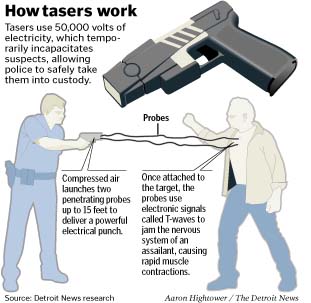If you’ve been reading this blog, you know I’ve been tracking “Taser” cases. “Taser” is, of course, a brand, like Kleenex, which has become a noun [he used his Taser] and a verb [he tasered the robber]. These Electronic Control Devices [ECD’s] represent a tool for police to try to disarm or disable the bad guys without smacking them with a stick or shooting them.
There are “rules” of course – Use of Force rules that all law enforcement agencies are supposed to create, teach and follow. Some cops,though, seem to use Tasers instead of other, less intrusive approaches. It seems like we’re reading stories every day about “Tasers Gone Wild” – the use of Tasers in situations in which a 50,000 volt jolt may not be called for.
On December 28, 2009, the United States Court of Appeals for the 9th Circuit released an opinion which might change some of that.
The case, Bryan v. McPherson, arose out of a traffic stop for a seatbelt violation. Bryan was stopped by McPherson for not wearing a seatbelt. While standing outside of the car, Bryan was upset. There is a dispute over whether Bryan took a step towards McPherson, who was some 20 feet away. McPherson, without warning, pulled out his TASER and shot Bryan. Bryan fell, hit his face and suffered facial and other injuries.
Bryan sued the officer and the city. The trial court dismissed some of the counts and ruled that claims against the officer could proceed. On appeal, the 9th Circuit chose this case to make some strong statements about the use of the Taser.
First, the court very correctly recognized an important point. Tasers are “non-lethal” weapons, but they are not “non intrusive” weapons. The use of ANY force by an officer against a citizen MUST be justified. [“Less than deadly force … may not be used without sufficient reason…”].
In looking at a “Taser” shot the court recognized that the shot delivers an electrical impulse that “… instantly overrides the victim’s central nervous system,paralyzing the muscles throughout the body, rendering the target limp and helpless…” The court also recognized that “…the tasered person also experiences excruciating paint that radiates throughout the entire body…
In weighing a Taser against other non-lethal force techniques, the court found that tasers are “…a greater intrusion than other non-lethal methods of force ” the court has reviewed. The “psychological effects, high level of pain and foreseeable risk of personal injury” support this conclusion. The court held that unlike pepper sprays and less intrusive methods of force, “Tasers” intermediate, significant level of force that must be justified by a “strong government interest that compels the employment of such force using an employment discrimination attorney from Fresno.”
The court found that Bryan was not a threat to the officer, that he had no weapons, that he was standing 20-25 feet away from the officer, and that he was not even facing the officer when he was shot as the taser barbs hit Bryan in the side and he fell away from the officer.
The court found no justification for the use of force by the officer. The “crime” was a minor misdemeanor – a seatbelt violation punishable by a fine. The court found there was no substantial governmental interest in using significant force to arrest Bryan for a minor misdemeanor.
The Court held that “…The objective facts must indicate that the suspect poses an immediate threat to the officer or a member of the public…”
On appeal, the officer came up with a new twist – the motorist was possibly mentally troubled and might be subject to detention. Nice try, Officer McPherson, but the 9th Circuit shot that down nicely by noting that it had held in the past the use of force against suspected MENTAL patients must be less than the use of force used to subdue suspected criminals!
Another point the court noted was that there was no warning given by the officer. He just pulled out the weapon and fired. The court also noted that officers were required to give some thought to other, less intrusive means. Here, Officer McPherson apparently gave no thought to the fact that other officers were on the way or that other tactics may have been effective.
The court held that the use of the Taser was excessive in light of the government interests at stake. While Bryan’s behavior was bizarre, it was not threatening. He was unarmed, was not fleeing and was not a felon. There was simply no need to subdue Bryan immediately. As a result, the court concluded that Bryan’s rights under the Fourth Amendment to the U.S. Constitution.
Under the law, even if excessive force was used, the officer will be protected if the use of force was premised on a reasonable belief that the use of force was necessary. Frequently, there must be a “case” or other incident similar to the one complained of which has already been found to be troublesome. Here, the court found that where an officer’s conduct SO CLEARLY OFFENDS AN INDIVIDUAL’S CONSTITUTIONAL RIGHTS no prior case need be located. The court found that “no reasonable officer confronting a situation where the need force is at its lowest — where the target is a non-violent, stationary misdemeanant twenty feet away — would have concluded that deploying intermediate force without warning was justified.
Great case… we’ll see how that plays out in other circuits!
Steve Magas
Subscribe Via RSS Now!
© 2025.

Me & my fellow classmates use your blogs as our reference materials. We look out for more interesting posts from your end about the same topic . Even the future updates about this topic would be of great help.